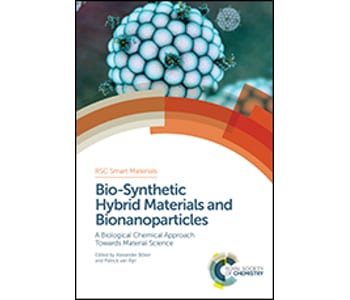Bio-synthetic Hybrid Materials and Bionanoparticles
Edited By Alexander Boker, and Patrick Van Rijn
Hardcover
ISBN: 978-1-84973-822-4
314 pages
Hardcover: £179.00
Click here for more information
Book reviewed by Dr. Fabio Nudelman, University of Edinburgh, Edinburgh, UK.
Using biomolecules, such as proteins, as building blocks for novel, functional synthetic materials is a strategy that is becoming increasingly important in chemistry. The high level of specialisation of such biomolecules, their functionalities and self-assembly capabilities make them suitable targets for approaches that exploit their physico-chemical properties for a wide range of technological applications.
The book “Bio-Synthetic Hybrid Materials and Bionanoparticles”, edited by Alexander Boker and Patrick van Rijn, gives a comprehensive review on the latest developments in the field of bionanoparticles and bionanoparticle hybrid systems that are based on protein building blocks. The book is structured in a logical, sequential manner and covers the main topics that are required for the development of novel nanoparticles and nanoparticle-based systems with interesting properties and applications: how to synthesize bionanoparticles and biohybrid structures; the properties and behaviour of bionanoparticles in solution and at interfaces; and finally, bionanoparticle-based functional materials and systems.
The first part of the book, entitled “Design and synthesis of bionanoparticles and biohybrid structures”, spans the initial 4 chapters. This part first discusses approaches for the modification of proteins with polymers or nanoparticles through covalent and non-covalent synthetic methods. These methods are particularly important, since the large variety of monomers and polymers with different functionalities, structures and properties that is available offers many possibilities for modifying and fine-tuning the properties of protein-hybrid polymers according to the desired function. The use of protein templates for the formation of inorganic-protein hydrid nanostructures are also described. These approaches are fascinating, as they seek to use the surface or cavities within protein cages as templates for nanoparticle formation. In this process, the assembly and disassembly of protein complexes can be exploited as well, to facilitate the incorporation or the release of nanoparticles from the cavity. Notably, cage proteins like ferritin or virus capsids are very attractive as templates for nanoparticle formation. The last two chapters of this part are devoted to describing methods to rationally modify protein templates to alter their function and properties, giving as examples the channel protein FhuA as a biomolecular scaffold, and virus capsids. One of the advantages in using proteins as templates is their intrinsic genetic programmability. This can be exploited through site-directed mutagenesis to add specific amino acids with functional groups with binding properties to inorganic materials, or specific reactivity to certain chemical groups.
The second part of the book, entitled “Bionanoparticle behaviour in solution and at interfaces”, spans chapters 5-7. Chapter 5 discusses the factors that govern the intra- and intermolecular assemblies of proteins, going from ferritin as a cage protein to collagen fibrils and virus particles as examples of more complex, highly organised supramolecular complexes. This chapter is nicely followed by a discussion on the use liquid/liquid and gas/liquid interfaces to direct the assembly of protein-based bionanoparticles. This chapter gives a good overview of the dynamics of this process, as well as experimental techniques to analyse the adsorption, assembly, denaturation and reorientation of proteins at interfaces. The last chapter on the second part describes the factors that influence protein adsorption on material surfaces at the liquid/solid interface. Importantly, the influence of electronstatic interactions, hydration and hydrophobic interactions and steric forces are considered, and the functionalisation of surfaces as a means to fine-tune the adsorption process is discussed.
After covering the design, properties and behaviour of bionanoparticles, the the third part of the book, “Bionanoparticle functional materials and systems” describes actual applications for these compounds. Chapters 8 and 9 deal with the use of virus particles as building blocks and templates for the synthesis of hybrid materials, leading to nanodevices such as nanowires, nanofilms, electrodes and catalysts. Chapters 10 and 11 discuss intriguing possibilities of synthesizing hybrid protein-inorganic structures with photoluminescent properties for bioimaging (chapter 10), and functional electronic devices such as nanowires, memory devices, biofuel cells (chapter 11). All these approaches and applications represent excellent ways in which the properties of proteins can be exploited in different forms, for different uses. The challenge with such organic-inorganic materials, however, is in bringing their synthesis from a small scale in a laboratory setting, to a large scale where they can be utilised in industrial settings, biomedical applications, etc. This limitation stems, at least in part, from the stability and durability of these compounds, the ease with which they can be manufactured in large quantities, and the costs. This highlights the need for improvements in the manufacturing techniques of these hybrid materials.
In conclusion, this book presents an excellent overview of the field on the topic of bionanoparticles and their applications, going from the fundamental aspects of particle synthesis to their properties and potential as functional materials.
Text kindly provided by Dr. Fabio Nudelman.

















